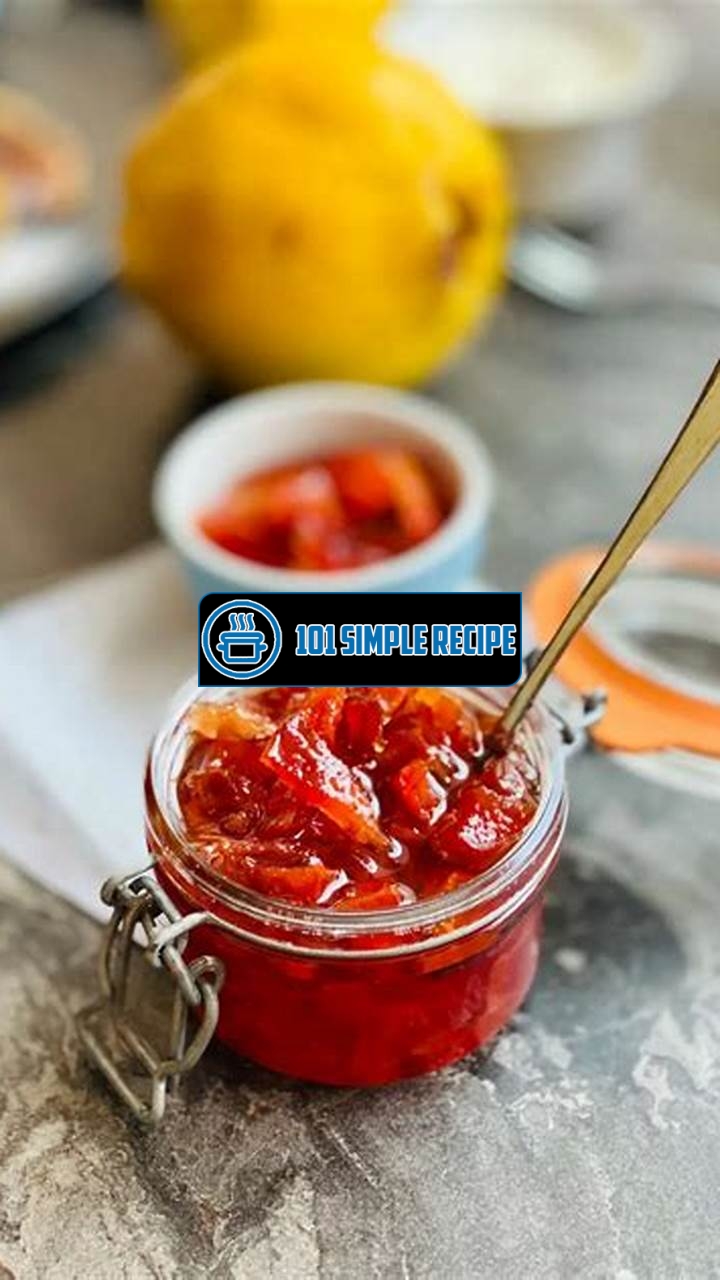Get ready to tantalize your taste buds with a delightful recipe for delicious quince jam! Made from the fragrant and juicy quince fruit, this sweet and tangy spread is the perfect addition to your breakfast table or afternoon tea. Whether you spread it on toast, use it as a filling for pastries, or simply enjoy it by the spoonful, this homemade quince jam is sure to become a favorite in your kitchen. So, grab your apron and let’s dive into this mouthwatering recipe that will leave you craving for more!

Understanding Quince
Discover all there is to know about the fruit that forms the basis of quince jam.
What is Quince
Quince is a fruit that belongs to the Rosaceae family, which also includes apples and pears. It is native to regions of Southwest Asia, including Iran and Turkey. Quince has a distinct aroma and a slightly gritty texture when raw, making it less desirable for eating fresh. However, when cooked, quince transforms into a deliciously fragrant and flavorful fruit.
Quinces are typically yellow or golden in color when ripe and have a unique shape resembling a combination of an apple and a pear. The fruit is commonly used in various culinary preparations, including jams, jellies, and desserts.
Key Points:
- Quince is a fruit from the Rosaceae family.
- It is native to Southwest Asia.
- Quince has a distinct aroma and gritty texture when raw.
- When cooked, quince becomes fragrant and flavorful.
- The fruit is commonly used in jams, jellies, and desserts.
Quince Varieties
There are several varieties of quince, each with its own unique characteristics. Some of the most popular varieties include:
- Cydonia Oblonga: This is the most common variety used for making quince products like jams and jellies. It has a rich aroma and a slightly acidic taste, which adds a tangy element to the final product.
- Smyrna: This variety is known for its large size and sweet flavor. It is often used for baking and making desserts.
- Portugal: The Portugal quince is smaller in size and has a smooth texture. It is favored for its delicate and aromatic flavor.
Key Points:
- Quince comes in various varieties with unique characteristics.
- Cydonia Oblonga is the most common variety used for making quince products.
- Smyrna quince is known for its large size and sweet flavor.
- Portugal quince is smaller and has a delicate, aromatic flavor.
Quince Nutritional Benefits
Quince is not only a tasty fruit but also offers several nutritional benefits. It is a good source of dietary fiber, vitamin C, and antioxidants. The fruit helps improve digestion, supports a healthy immune system, and may even have anti-inflammatory properties.
In addition to these benefits, quince is low in calories and fat, making it a healthy choice for those watching their weight. Its high fiber content also aids in healthy digestion and can help prevent constipation.
Key Points:
- Quince is a good source of dietary fiber, vitamin C, and antioxidants.
- The fruit helps improve digestion and supports a healthy immune system.
- Quince has potential anti-inflammatory properties.
- It is low in calories and fat, making it a healthy choice.
Note: Quince jam is a delicious way to enjoy the unique flavor and nutritional benefits of quince. Blending the sweet and tangy taste of quince with sugar creates a delightful spread that can be enjoyed on toast, scones, or even as a glaze for meats.
Ranch Oyster Crackers Recipe is a savory snack that is easy to make and full of flavor. It pairs well with your Quince Jam for a tasty appetizer.
Why Make Quince Jam
There are several compelling reasons why making quince jam should be on your culinary to-do list. Not only is it a delicious addition to your repertoire, but it also offers a wide range of culinary uses and health benefits. Let’s explore why quince jam is worth making:
Quince Jam Uses
Quince jam is incredibly versatile and can be used in a variety of ways. Its sweet and tangy flavor profile makes it a perfect accompaniment to both sweet and savory dishes. Here are some popular uses for quince jam:
- Spread it on toast or croissants for a delightful breakfast treat.
- Use it as a filling for pastries and tarts, adding a burst of flavor to your baked goods.
- Pair it with cheese and crackers for a delicious appetizer or snack.
- Add it to yogurt or oatmeal for a sweet and tangy twist.
- Use it as a glaze for roasted meats, adding a depth of flavor to your main dishes.
Tip: Quince jam can also be used as a topping for ice cream or pancakes for a decadent dessert.
Health Benefits of Quince Jam
In addition to its incredible taste, quince jam also offers several health benefits. Quince fruit is rich in antioxidants, vitamins, and minerals that can support your overall well-being. Here are some of the health benefits associated with quince jam:
- Boosts immune system: Quince is packed with vitamin C, which can help strengthen your immune system and fight off infections.
- Supports digestion: Quince contains dietary fiber, which aids in digestion and promotes a healthy gut.
- Improves heart health: Quince is low in cholesterol and sodium, making it a heart-healthy choice that can help lower blood pressure and reduce the risk of heart disease.
- Rich in minerals: Quince is a good source of minerals like potassium, copper, and iron, which are essential for various bodily functions.
Fun fact: Quince jam is a great way to enjoy the health benefits of quince fruit while satisfying your sweet tooth.
Culinary Uses for Quince Jam
Quince jam is a beloved ingredient in many culinary traditions and cuisines around the world. Its unique flavor and versatility make it a popular choice among chefs and home cooks alike. Here are some common culinary uses for quince jam:
- Pastry fillings: Quince jam can be used as a filling for pies, tarts, and turnovers, adding a burst of flavor to your baked goods.
- Marinades and glazes: The sweet and tangy nature of quince jam makes it an excellent choice for marinades and glazes, enhancing the taste of meats and vegetables.
- Sauces and dressings: Quince jam can be transformed into a delicious sauce or dressing by adding some vinegar or citrus juice to balance out the sweetness.
- Accompaniment to cheese: Quince jam pairs perfectly with a variety of cheeses, creating a delightful combination of sweet and savory flavors.
️ Pro tip: Try spreading quince jam on a grilled cheese sandwich for a delightful twist on a classic favorite.
In conclusion, quince jam is a versatile and delicious addition to any kitchen. It offers a multitude of uses, such as a spread, filling, glaze, or topping, allowing you to explore your creativity in the culinary realm. Not only does it provide a burst of flavor, but it also delivers several health benefits. So, why not try making your own quince jam and enjoy its sweet and tangy delight?
Cookie in a Mug Recipe is a quick and easy dessert that you can make in just a few minutes. It’s the perfect treat to enjoy alongside your Quince Jam.
Preparing Quinces for Jam Making
Learn the essential steps to prepare quinces for the jam-making process.
Choosing Ripe Quinces
When it comes to making delicious quince jam, the first step is to choose the ripest quinces available. Look for quinces that have a bright yellow color and are slightly soft to the touch. These characteristics indicate that the fruit is at its peak ripeness and will result in a jam with the perfect balance of sweetness and tanginess.
Washing and Cleaning Quinces
To ensure that your quince jam is not only delicious but also safe to consume, it’s important to thoroughly wash and clean the quinces before using them. Start by rinsing the quinces under cool running water to remove any dirt or debris. Then, using a vegetable brush, gently scrub the surface of the quinces to remove any residual dirt or wax. Once clean, pat the quinces dry with a clean towel. This step will help prevent any unwanted contaminants from ending up in your jam.
Peeling and Cutting Quinces
Now that your quinces are clean, it’s time to prepare them for the jam-making process. Start by peeling the skin off the quinces using a sharp knife or a vegetable peeler. The skin of the quince can be tough and bitter, so removing it will ensure a smoother texture and better taste for your jam. Once peeled, cut the quinces into quarters and remove the core and seeds. You can use a paring knife or a spoon to easily remove the core from each quarter. Then, proceed to cut the quinces into small, uniform pieces. This will help the quinces cook evenly and ensure a consistent texture in your jam.
By following these essential steps in preparing quinces for jam making, you’re setting yourself up for success in creating a delicious and tangy quince jam. Remember to choose ripe quinces, wash and clean them thoroughly, and peel and cut them before proceeding with the jam-making process. Enjoy the delectable flavors of quince with every spoonful of homemade jam!
Punch Bowl Recipe is a delicious and refreshing drink that can be enjoyed at parties and gatherings. It’s the perfect complement to your Quince Jam recipe.
The Jam-Making Process
Are you ready to embark on a delicious journey of making homemade quince jam? Get ready to experience the delightful aroma and taste of this sweet and tangy treat. In this article, we’ll guide you through the step-by-step process of turning quinces into delectable jam, from simmering the quinces to jarring and storage.
Simmering Quinces
The first step in creating the perfect quince jam is to simmer the quinces. Begin by washing and peeling the quinces, then cut them into chunks or slices. As you prepare the quinces, take a moment to appreciate their unique fragrance and vibrant color.
Place the quince pieces in a large pot and add enough water to cover them. Bring the water to a boil and then reduce the heat to a simmer. Let the quinces simmer for approximately 20-30 minutes until they become tender and start to release their natural juices. While waiting, you can enjoy the delightful scent of the quinces filling your kitchen.
Once the quinces are tender, remove them from the heat and allow them to cool slightly. Then, using a potato masher or a fork, mash the quinces until you achieve a chunky consistency. The mashed quinces will form the base of your jam and contribute to its rich texture.
Adding Sugar and Flavorings
Now that you have prepared the quinces, it’s time to add the key ingredients that will transform them into a delectable jam. Start by measuring the mashed quinces and transferring them back to the pot. For every cup of mashed quinces, add an equal amount of sugar. This ratio ensures a perfect balance of sweetness and tanginess.
In addition to sugar, you can enhance the flavor of your quince jam by incorporating various spices or citrus zest. Common additions include cinnamon, cloves, or a hint of lemon zest. These flavorings will elevate the taste profile of your jam and provide a delightful burst of aroma.
Once the sugar and flavorings are added, bring the mixture to a rolling boil while stirring constantly. This will allow the sugar to dissolve completely and thicken the jam. Boil the mixture for about 15-20 minutes until it reaches the desired consistency. Keep in mind that the jam will continue to thicken as it cools.
Jarring and Storage
After you have achieved the perfect consistency for your quince jam, it’s time to transfer it into jars for storage. Make sure to sterilize the jars and lids beforehand to ensure the jam stays fresh. Carefully ladle the hot jam into the prepared jars, leaving about 1/4 inch of headspace at the top. This space allows for expansion during the cooling process.
Once the jars are filled, securely seal them with the lids and place them in a water bath canner. Process the jars in boiling water for about 10-15 minutes to create a proper seal. This step is crucial for preserving the jam and extending its shelf life. After the processing time, carefully remove the jars from the canner and let them cool completely before storing them in a cool, dark place. ️
Now that you have completed the jam-making process, you can enjoy the fruits of your labor by spreading the sweet and tangy quince jam on toast, scones, or even using it as a filling for pastries. The possibilities are endless, and the satisfaction of creating your own homemade jam is truly rewarding.
In conclusion, by following this step-by-step process, you can create a mouthwatering quince jam that will impress your family and friends. So why not give it a try and indulge in this delightful homemade treat? Happy jam-making!
Troubleshooting Quince Jam-Making
When it comes to making quince jam, there are a few common issues that can arise during the process. However, with the right solutions, you can ensure a successful outcome and enjoy a delicious sweet and tangy delight. Let’s address these issues and find ways to overcome them.
Setting Issues
One common problem that may occur when making quince jam is difficulty in achieving the desired setting consistency. This can result in jam that is either too runny or too firm. To ensure the perfect setting, it is essential to follow the instructions precisely and make the necessary adjustments if needed.
- Ensure proper cooking time: It’s crucial to cook the quince mixture for the recommended time to allow the natural pectin in the fruit to activate. This will help the jam to set properly.
- Test for setting point: To check if the jam has reached the desired setting point, you can perform the wrinkle test. Simply place a small amount of jam on a chilled plate and push it gently with your finger. If it wrinkles and holds its shape, it is ready. If not, continue cooking for a few more minutes and test again.
- Use lemon juice: Adding a squeeze of lemon juice to the quince mixture can help enhance the natural pectin content and improve the setting process.
Texture Problems
Another common issue that may arise is texture problems in quince jam. It can be frustrating to end up with a jam that has a grainy or mushy texture instead of a smooth and luscious one. However, there are several ways to troubleshoot and achieve the desired texture.
- Choose ripe and fresh quinces: Using ripe and fresh quinces will contribute to a smoother texture in the jam. Avoid using overripe or damaged fruits as they may affect the final result.
- Properly puree or chop the fruit: Ensure that the quinces are properly pureed or chopped before cooking. This will help create a more consistent texture in the jam.
- Stir regularly: During the cooking process, make sure to stir the quince mixture regularly. This will help distribute the heat evenly and prevent the fruit from sticking to the bottom of the pan, which can result in a grainy texture.
- Add pectin: If you’re still not satisfied with the texture of your quince jam, you can consider adding a commercial pectin to help achieve the desired consistency. Follow the manufacturer’s instructions for the correct amount to use.
Storage and Shelf Life
Once you’ve successfully made your quince jam, you need to store it properly to maintain its quality and maximize its shelf life. Here are some tips to ensure long-lasting enjoyment of your homemade jam:
- Use proper jars and lids: Transfer the jam to clean, sterilized jars with airtight lids. This will help prevent spoilage and maintain freshness.
- Store in a cool and dark place: Quince jam should be stored in a cool and dark pantry or kitchen cabinet. Avoid exposing it to direct sunlight or heat, as this can affect its taste and texture.
- Check for signs of spoilage: Before consuming the jam, always check for any signs of spoilage such as mold growth, unpleasant odor, or unusual texture. If any of these are present, discard the jam immediately.
- Respect expiration dates: While homemade quince jam can last for several months when stored properly, it’s always a good idea to label the jars with the date of preparation and consume the jam within a year to ensure optimal flavor and quality.
By addressing common issues in quince jam-making and following these troubleshooting steps, you can create a perfect batch of delicious quince jam. Enjoy the sweet and tangy delight on toast, scones, or as a delightful accompaniment to cheese!
Frequently Asked Questions
Thank you for reading our article on quince jam recipe! If you have any lingering questions, take a look at the FAQs below:
| No. | Questions | Answers |
|---|---|---|
| 1. | Can I use ripe quinces for this recipe? | It’s best to use slightly underripe quinces as they will yield the best results and set properly. |
| 2. | Can I substitute sugar with a sweetener? | Yes, you can substitute sugar with a natural sweetener like honey or maple syrup, but the taste and consistency may vary. |
| 3. | How long can I store the quince jam? | When properly stored in sterilized jars, the quince jam can last up to a year in a cool and dark place. |
| 4. | Is it necessary to peel the quinces? | Yes, it is important to peel the quinces before making jam to remove any bitter taste and ensure a smooth texture. |
| 5. | Can I add other fruits to the quince jam? | Absolutely! You can experiment by adding a small amount of other fruits like apples or pears to enhance the flavor of the quince jam. |
| 6. | Can I use this recipe to make quince paste? | No, this recipe is specifically for quince jam. To make quince paste, you’ll need a different recipe and cooking method. |
Thanks for Reading and Visit Again Soon!
We hope you enjoyed learning how to make quince jam with our easy-to-follow recipe! Don’t hesitate to come back for more delicious recipes and kitchen inspiration. Remember, homemade jams are a delightful way to add flavor and charm to your meals. So roll up your sleeves and get jamming, you’ll be rewarded with sweet satisfaction! Until next time, happy cooking!
Jump to Recipe
Quince Jam Recipe

Learn how to make delicious homemade quince jam with our easy-to-follow recipe. Perfect for spreading on toast or using in pastries! Discover the joy of preserving quinces in a sweet and flavorful jam.
- 3 lbs quinces (peeled, cored, and chopped)
- 3 cups granulated sugar
- Juice of 1 lemon
- Peel, core, and chop the quinces into small cubes.
- Place the quince cubes in a large saucepan. Add the sugar and lemon juice. Cook over medium heat, stirring frequently, until the sugar has dissolved and the quinces have softened, about 10 minutes.
- Reduce the heat to low and let the mixture simmer, uncovered, for 1-1.5 hours, or until the jam reaches a thick consistency. Stir occasionally to prevent sticking.
- Sterilize jars and lids. Carefully pour the hot jam into the sterilized jars, leaving a little space at the top. Seal tightly and let cool completely. Store in a cool, dark place for up to a year.
- Spread the quince jam on toast, use it as a filling in pastries, or pair it with cheese for a delightful combination. Enjoy your homemade quince jam!






